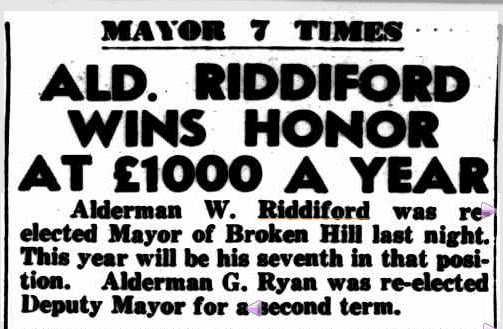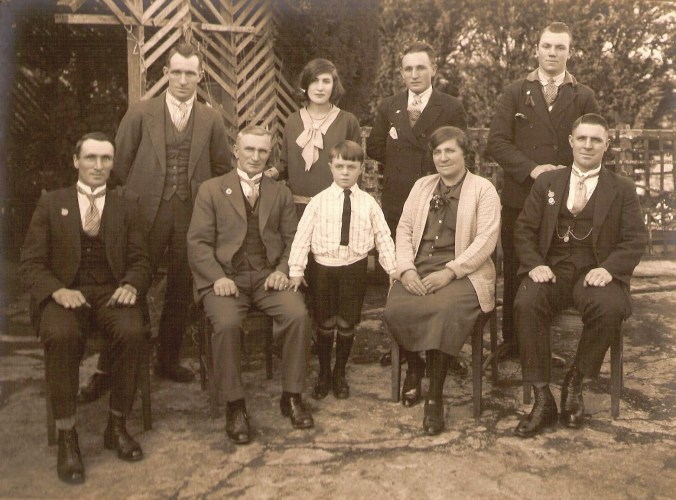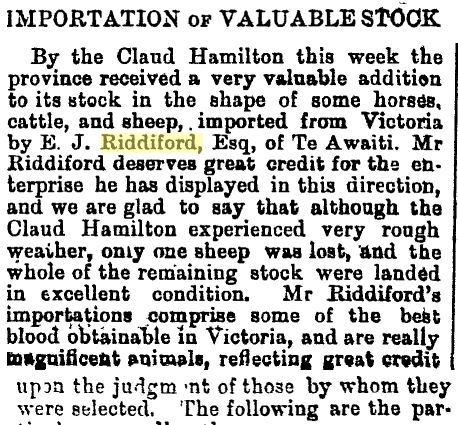I had considered “R’ week of the Gould Genealogy Alphabet Challenge an opportunity to trot out my Riddiford family as they are, strictly speaking, not a Western District Family. However, after initially being excited at the prospect of bringing together their rich history, I soon realised I had too much information to give a summary while still doing justice to the many stories I have found.
Now how am I going to tell you about the family of fabric workers from Gloucestershire, dating back to at least the 1500s, who spread across England, into Wales and then Canada, the United States, and Australia? I really want to tell you about the criminals, including Dinah Riddiford, the oldest woman to hang in England in the 18th and 19th century and the convicts transported to Van Diemens Land, Sydney and Norfolk Island.
Then there is the story waiting to be told of the Riddifords of New Zealand, original settlers in the country, with Daniel Riddiford arriving in 1840 and making a large contribution to the pastoral history of the country. Descendants of the Wellington pioneers have gone on to climb Mount Everest with Sir Edmund Hillary, sit in the New Zealand parliament, play cricket for New Zealand and direct, write and produce for film and television, just to name a few.

NINE GAMBLE DEATH TO SEE ROOF OF THEY. (1952, February 23). Examiner (Launceston, Tas. : 1900 – 1954), p. 14. Retrieved September 6, 2012, from http://nla.gov.au/nla.news-article52848815
Or there are the Riddifords that immigrated to Australia arriving to South Australia, Queensland, New South Wales, and Victoria. These included one of the most renowned Australian Riddifords, Walter Riddiford of Broken Hill. The former miner and mayor of Broken Hill had the Riddiford Arboretum in the town named in his honour.

MAYOR 7 TIMES ALD. RIDDIFORD WINS HONOR AT £1000 A YEAR. (1954, December 17). Barrier Miner (Broken Hill, NSW : 1888 – 1954), p. 4. Retrieved September 5, 2012, from http://nla.gov.au/nla.news-article49976381
I also would like to tell you about my Riddiford line including my ggg grandfather, Charles Riddiford, a tailor and policeman who died in the Saunderton Union Workhouse at Wycombe, Buckinghamshire. And his son Thomas Cooke Riddiford, some time publican and butcher who immigrated with his family to Canada in search of a better life, only to return to Buckinghamshire a few years later.
I will, however, get the chance to tell you the story of my grandfather and great-grandfather, Percy and Tom.
Thomas William Cooke Riddiford, the fourth of eight children, was born in 1875 at the Crown Inn, Aylesbury Road, Cuddington, Buckinghamshire not long after his family had returned to England from a failed venture to Brant County, Ontario, Canada.
While still a baby, Tom’s parents Thomas Cooke Riddiford and Emma Piddington moved the family to Clerkenwell, London where Lily Beatrice was born in 1877. Again, the move seems to have been another failed attempt to find a better life for the family, as they had headed back to Cuddington by 1879. Thomas senior resumed his role as publican of the Crown Inn. Emma’s father, a victualler, also had links to that pub and others in the district. In 1883, Emma died aged 34 and Thomas was left with eight children to care for, with three under five.
How does a family manage after such a tragedy? By the 1891 UK Census, the consequences of Emma’s death had become evident. On the night of the Census, the two youngest children, Ernest Arthur, 11 and William Leonard, 10, were at the Aylesbury Union Workhouse. Youngest daughter Florence, 12, was living with her grandmother, Jane Piddington, and Lily, aged 14 was a servant for an Aylesbury hairdresser. My great-grandfather Tom, then 16 was boarding at the Plough Inn, Haddenham, working as an apprentice butcher.
Where was Thomas senior by this time? He had moved on. To Manchester in fact, working as a cab driver and living with his new wife, Sarah Browne, and their four-month-old son, Arthur. The saddest part of this stage in their lives is that I have never been able to find any trace of Ernest beyond the 1891 Census and his time in the Workhouse. My grandfather named a son after his younger brother. A tribute maybe?
Tom junior got on with his life, making a move to London working as a fully qualified butcher. He married 18-year-old Londoner Caroline “Queenie” Celia Ann Kirkin on February 7, 1896, at St Barnabus Church, Kennington, London. By the time of the 1901 UK Census, the couple was living at 169 Cromwell Road, Kensington with three sons. Tom was working for himself as a butcher.
In 1903, the family suffered a loss with the death of two-year-old Horace. Percy Ronald Riddiford, my grandfather, was born in Leytonstone in 1904 before a break of six years when Reginald was born in 1910 at Edmonton. That is where the family was living at the time of the 1911 UK Census, 54 Raynham Road, Upper Edmonton. Oldest son William was 14 and working as a metal polisher, Cyril 13, was attending school and working as an errand boy for a greengrocer. Father Tom was still a butcher, working for Universal Stores.
The former Riddiford home, possibly their last in England, is the cream house with red flower baskets.
Something must have nagged at Tom. A feeling like his father before had felt. How could he make a better life for his family? In 1906, he had travelled alone to Halifax, Nova Scotia, Canada on what appears to have been a reconnaissance trip, but he returned to London. In 1912, Tom’s cousin Aubrey Frank Riddiford immigrated to Australia, settling at Heyfield in Gippsland. This may have been the catalyst for Tom to pack up the family and sail to Australia aboard the “Commonwealth” arriving in Melbourne on September 15, 1913. Many of the passengers were Assisted Immigrants and I would assume the Riddfords were among them.

SS Commonwealth 1911 at a pier at Adelaide.
Courtesy of the State Library of South Australia, B69878
http://images.slsa.sa.gov.au/mpcimg/70000/B69878.htm
The Riddifords moved to Smeaton, just north of Ballarat. Lillian Ivy, the only girl in a family devoid of women, was born in 1914. War broke out and in 1915 Bill enlisted for his new country, followed by Cyril in 1916 and Ern in 1918. Bill was hit by an Army ambulance in France and was sent home an invalid in 1917.

ALLENDALE. (1917, July 21). The Ballarat Courier (Vic. : 1914 – 1918), p. 10 Edition: DAILY.. Retrieved September 6, 2012, from http://nla.gov.au/nla.news-article73320328
In 1922, Stanley was born at Smeaton, 26 years younger than his oldest brother Bill.
By the end of the 1920s, the Riddifords moved into Ballarat, residing at 97 Humffray Street South. Tom and Queenie then moved to 619 Humffray Street where they remained until their deaths.

The Riddiford Family of Ballarat circa 1929
Back: Cyril Victor, Lillian Ivy, Percy Ronald, Reginald Leonard
Front: William “Bill” Thomas Frederick, Thomas William Cooke Riddiford, Stanley Gordon, Caroline “Queenie” Celia Ann Kirkin, Ernest Arthur Harold.
This photo is very special because of the circumstances in which I came to have it. Mum and I visited an antique shop at Newlyn, north of Ballarat. We spotted some old photos with the penciled name “Riddiford” on the cardboard frames. There were three, including the family photo and a wedding photo of my grandfather and his first wife Mavis McLeish. The shop owner was able to tell us how he acquired them, but it’s a long story.
Thomas passed away in 1957 aged 81 and Caroline in 1962 aged 83. They are buried at the Ballarat New Cemetery.
The boys and Lillian married, and all but Bill had children. But there were few descendants as the seven children produced only 16 grandchildren, seven of them by my grandfather! Of those, there were five girls and nine boys. Seven of those boys were my grandfathers!
The most successful of Tom and Caroline’s descendants to date has been Ern’s son Leonard Riddiford. Len gained a scholarship to Melbourne High School and then studied physics at Melbourne University. During the late 1940s, he travelled to Birmingham to work on the world’s first synchrotron under Sir Mark Oliphant’s guidance, while completing his PhD at Birmingham University.

ATOM STUDY IN AUSTRALIA. (1952, August 22). The Sydney Morning Herald (NSW : 1842 – 1954), p. 2. Retrieved September 6, 2012, from http://nla.gov.au/nla.news-article18278393
To think the Riddifords were the last branch I researched. As they arrived in 1913 and with my main interest being 19th-century Australian history, I considered them newbies. But when I did seriously begin researching the name I couldn’t stop, not returning to research my other families for months. The research experience was also very different from my other families. While I have little information on my Victorian pioneer families prior to their departure from England, I have easily found information on the Riddifords from a variety of sources.
I have also had the pleasure of tracking my grandfather and great-grandfather right through to the 1911 UK census when my other families left soon after the 1851 Census. It has also given me a greater understanding of English history, geography, and records.
The Riddifords of New Zealand consumed a lot of my time and Papers Past got a workout. There are over 54,000 “Riddiford” matches at the New Zealand newspaper archive compared to 3449 on the same search at Trove and I have spent months just on this branch trawling through articles and books about the history of New Zealand.
Although I still have some brick walls, I can safely say that Riddifords everywhere are related. Like a jigsaw, all the pieces have come together to form a picture of a family who today can trace their links back to those early Gloucestershire cloth makers and, if my theory is correct, back to the Flemish cloth workers who arrived in Gloucestershire from the 1300s-1500s. That is another facet of the tale I had intended to share.
A book on the Riddiford family history would be the best way to do the stories justice. I have even considered a One-Name study or at the very least, a blog. I don’t think I can manage any of those options at the moment. While writing Western District Families has given me an outlet for most of my families, it has also presented a problem. My Riddiford research has fallen into a state of neglect.
RIDDIFORD TRIVIA
It is was not only genealogists who welcomed online records. Tabloid newspapers soon became fans too. This was evident in 2010 when a journalist wrote on the ancestry of Kylie Minogue. Numerous newspapers and magazines ran with the story chiefly because Kylie had not one but several criminal ancestors. Who were they? Well they were Riddifords! Yes that’s right Kylie and Dannii Minogue are Riddiford descendants.
Many Riddifords knew this prior to 2010 and I had myself read that the Kylie and Dannii’s mother was a Riddiford. It was actually her grandmother Millicent Riddiford, one of the Welsh Riddifords. Millie arrived in Australia in 1955 with her husband Denis Jones and their children. By my calculations that would make the Minogues my 7th cousins, as we share 6 x great grandparents Thomas Riddiford and Arabella Trottman. Distant I know, but the 8-year-old research assistant is very proud of his link, even if the kids at school won’t believe him.
An article from the Daily Mail of February 2, 2010, describes the Riddiford/Minogue relationship – Hangings, Sex Assaults and Deportation: Meet Kylie Minogue’s Criminal Ancestors…
I would like to trace the Minogue line to see if Kylie and Dannii descend from the Minogue family, pioneers of Cape Bridgewater in south-west Victoria. They too may have Western District Families.
Call it a family myth, but another piece of trivia Riddifords like to hang their hat on, is the link between Ronnie Barker and L.E Riddiford Grocers in Thornbury Gloucestershire. The story goes that while Barker was filming in Thornbury, he was so inspired by the grocers store in High Street that he created the show Open All Hours. If you look at the L.E.Riddiford website you will understand how this comparison may have come about.
MY FAVOURITE RIDDIFORD
This would be Edward Joshua Riddiford, born in the Hutt Valley, Wellington, New Zealand in 1842, son of Daniel Riddiford and Harriet Stone. Educated in Australia at Scotch College, Melbourne, Edward spent time on cattle stations in Queensland. He often visited Australia and on at least one occasion bought stock from the Learmonths of Ercildoune near Ballarat.

IMPORTATION of VALUABLE STOCK.
Evening Post, Volume X, Issue 134, 25 July 1874, Page 2
Papers Past – http://paperspast.natlib.govt.nz/cgi-bin/paperspast
The reason I particularly like Edward Joshua Riddiford is for the relationships he forged with the Maori people. This quote from Edward’s biography by Roberta Nicholls for Te Ara – The Encyclopedia of New Zealand sums him up well:
“At Te Awaiti and Orongorongo Edward Riddiford interacted constantly with the local Maori population, as he had done when he was a child. He spoke their language, employed them, shod their horses, and bartered domestic products, foodstuffs and clothing for crops and wild pork. He played cards and drank with the men; he slept with the women. Out of admiration for his forceful leadership, commanding personality, and physical prowess the Maori called him ‘King’. Because of his influence, Riddiford was able to acquire Maori land for leasehold or freehold on favourable terms.” (from the biography of Edward Joshua Riddiford, by Roberta Nicholls, Te Ara – The Encylopedia of New Zealand)
THE RIDDIFORD FAMILY ON FACEBOOK
If you are a Riddiford descendant you are more than welcome to join our Facebook group. Search “The Riddiford Family” at Facebook and you will find us. There are 130 Riddifords from all over the world. Many have commented on how they thought were the only Riddifords, rarely coming across others with the same surname. That’s what I used to think growing up in Hamilton in the 70s and 80s. Mum, Dad, and I were the only three Riddifords anywhere in the world except for Grandpa and Grandma Riddiford and my uncles in Ballarat. How wrong we were!



You must be logged in to post a comment.